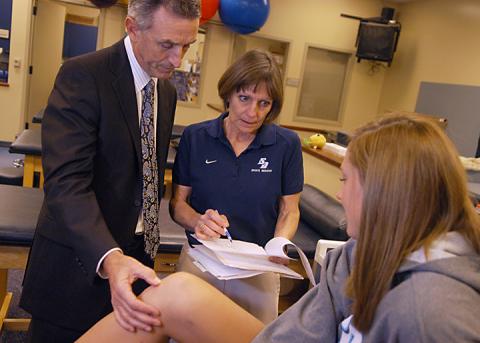
The April NATA News featured an article on disablement models and the World Health Organization’s International Classification of Functioning, Disability and Health. Below is a more in-depth look at the subject.
ICF Model: A Framework for Athletic Training Practice
By Sara Nottingham, EdD, ATC, Carrie Meyer, EdD, ATC, and Barbara Blackstone, MSS, ATC
In 2012, the NATA Board of Directors approved the Future Directions in Athletic Training Education document,1 which outlined 14 recommendations developed by the Executive Committee for Education (ECE). Recommendation No. 10 suggests adoption of a practice model utilizing contemporary disablement model language. In December 2015, after recommendation by the ECE, the NATA BOD approved the adoption of the World Health Organization’s International Classification of Functioning, Disability and Health (ICF)2 with the Children and Youth (ICF-CY) updates.
What are Disablement Models?
Disablement models are conceptual models that provide a framework for clinical practice and research.3 Most health care professions use disablement models as a method of organizing clinical practice decisions because they are a critical piece of practicing evidence-based medicine.3 Recall the components of Evidence-Based Practice: clinician expertise, research evidence and patient preferences and values. As health care professionals, it is important to integrate research evidence and our patients’ values into their care, in addition to our clinical expertise. Using a disablement model facilitates this by capturing our patients’ experiences in addition to our objective measures.3 Lastly, documentation with the use of a disablement model provides a mechanism for conducting research on the effectiveness of our therapeutic interventions, demonstrating the value of athletic training services.3
What is the ICF model?
The ICF provides a framework for organizing and documenting functioning and disability.2 Utilization of this model provides a common language and method for discussing, documenting and tracking outcomes related to our practice. The ICF offers a multidimensional aspect to view health and disability describing it as “a dynamic interaction between a person’s health condition, environmental factors and personal factors.” (4, p5) The health condition is influenced by body functions and structures, activities the person does, and their participation in life situations as well as personal and environmental elements (Figure 1). Athletic trainers care for diverse and complex patient populations. When examining our patients through the lens of ICF, it allows us a broader context for providing the best evidence-based care to them.

The ICF model organizes the injury or illness in two components: 1) functioning and disability and 2) contextual factors.2 Component one can be further divided into body functions and structures, activities and participation. Body functions and structures are the anatomical and physiological aspects that are affected by or cause the condition. Activities are defined as tasks or actions taken by an individual whereas participation is “involvement in life situations.” 2 Life situations can include things such as participating in a sport, school or community.
The second component, contextual factors, can be categorized as personal or environmental factors. Personal factors can include additional health problems the patient has as well as age, gender, race, lifestyles and habits, among others. Environmental aspects include “the physical, social and attitudinal environment in which people live.”4
The ICF model is also designed to allow for quantification of function. The ICF model allows the clinician to code for both functions and structures to qualify both the extent of the impairment and the nature of the change.3 Activities and participation, environmental factors as well as personal factors will all be coded with qualifiers to give the clinician the opportunity to note disability, dysfunction and the changes made through interventions.5 The classification and coding of function are then integrated throughout patient care documentation.
Documentation with the ICF Model
Documenting patient care is essential for all healthcare providers, including athletic trainers.6-9 Quality documentation facilitates effective patient care, communication between healthcare professionals, and aids in demonstrating value of athletic training services.10-12 Documentation is also an important component of the ICF model. Quantitatively measuring your patient’s overall function both subjectively and objectively is important. Quantitative measures provide an assessment of where the patient is currently, providing a starting point for setting goals, and measuring improvement throughout their treatment. The ICF model includes capacity qualifiers to document patient function (Figure 2).2

Clinicians can use these capacity qualifiers to subjectively and objectively assess function on a scale from zero to 100 percent. For example, the capacity qualifier can be used by asking your patient: “On a scale from zero to 100 percent, zero percent being no problem and 100 percent being total inability to complete a task, how well can you currently function in your activities of daily living?” This percent can then be categorized with a simple number between zero to four that can then be used for coding and billing purposes.2 Similarly, a clinician can use the capacity qualifiers to objectively assess a patient’s function during a task such as walking.2
In addition to capacity qualifiers, patient-rated outcome measures (PROMs) are standard measures of assessing patient status and improvement in health care.13 The use of PROMs have been discussed in athletic training for several years as a means to assess function and quality of life from the patient’s perspective.14-18 Using PROMs is an important component of providing evidence-based care, especially when capturing patient preferences and values.18 Ultimately, PROMs assess a patient’s health status and perception of function, arguably the most impactful assessment of treatment effectiveness.18 PROMs should be used in conjunction with ICF capacity qualifiers to provide a holistic assessment of patient function.
Application of ICF model to athletic training
Consider a high school boys basketball athlete who has sustained a distal radial fracture. Figure 3 illustrates a few of the aspects of the patient’s condition organized within the ICF model.

By applying the ICF model to this patient, we can see the influences of his condition on other areas of his life and vice versa. The ICF model helps us consider that this patient’s lack of health insurance and single-parent status (environmental factors) may affect the impact of this injury on his life. Likewise, documenting activity limitations captures the impact of this patient’s injury on his activities of daily living such as completing his academic responsibilities (activity limitations). Using the ICF model allows us as his health care provider to address these areas other than his sport participation, helping to provide holistic patient care.2
We can utilize this framework during all of the interactions we have with this patient from initial assessment through treatment and return to full functioning. Incorporation of the ICF model during the assessment process aids in quantifying the level of function of a patient. Utilizing the capacity qualifiers scale from zero to 100 percent (Figure 2),2 both the clinician and the patient can rate how much the health condition has affected him. By having our example patient assess his difficulty using this scale, we can get a better view of how much this condition is affecting this patient’s overall functioning. For example, if the patient feels that he has a 75 percent limitation in his ability to complete his school activities (typing, writing, putting on a backpack), he would have a three, or severe, limitation. The clinician could also observe the patient’s ability to pick up a pencil and write, which would allow him or her to objectively assess the patient’s status using the same scale. Knowing the patient has severe activity limitations the clinician would focus on improving his ability to complete activities of daily living before addressing his ability to participate in basketball. Likewise, we should ask our patient to complete a general health-related quality of life (HRQL) PROM such as the Short-Form 12 (SF-12) and a region-specific PROM such as the upper extremity functional scale. These quick patient-rated assessments provide additional detail on our patient’s status and can be easily communicated between health care professionals.
Treatment with the ICF model in mind will help the clinician focus on the holistic, comprehensive problem list developed through your complete assessment. The quantification of patient functioning determined during the assessment provides a foundation for setting treatment goals and a treatment plan.4-5 Interventions will target the needs of the patient and will change as the patient progresses through the phases of treatment. For example in our upper extremity injury case, these interventions could include early motion with support, manual therapy, and physical agents that reduce his pain so he can sleep better and be more comfortable during the day. Interventions can then focus on regaining range of motion and therapeutic exercises to improve his ability to type, hold a pencil and eventually do basic basketball drills (e.g. dribbling). The clinician should continually reassess the patient’s progress in relation to their goals, ensuring the interventions are helping the patient improve. Including subjective patient status using capacity qualifiers and PROMs is critical to capturing their overall function. Thus, we would hope to see a gradual improvement from a severe limitation to a moderate, then mild, limitation.
The clinician can integrate their clinical expertise along with best research evidence to inform their treatment decisions that address these impairments and related limitations and restrictions.5 As our patient continues to improve from our therapeutic interventions, we can document their improvement over time both subjectively and objectively. If referral to another health care provider is warranted, continuity of care should be smooth due to use of the same language of disablement and function. Therapeutic interventions documented with the ICF model can then be applied to billing codes used for reimbursement purposes. Even if the athletic trainer is not reimbursing for services, these same codes can be used to quantify the value of the athletic training services provided.14-15,18
Integration into clinical practice
Now that you’ve learned more about this disablement model, the natural question is “What do I do next?” When determining how to integrate the ICF model into your clinical practice, you may want to start with a self-assessment of what you are already doing as a clinician by asking yourself the questions below:
- As I assess and treat a patient, am I considering their preferences and values in my care?
- Am I considering all components of the ICF model when diagnosing and treating patients?
- Am I using a combination of subjective and objective outcome measures in my clinical practice?
- Are my treatment decisions grounded in these subjective and objective measures?
- Am I documenting not only what care is provided, but how my patients are responding to this care?
Once you’ve reflected on your current approach to patient care and use of Evidence-Based Practice, you can identify areas where you can begin integrating elements of the ICF model. Start by asking your patients about how their injury or condition is influencing their activities of daily living, environmental factors, and personal life when assessing their injury or condition. Avoid focusing only on sport participation. While this is an important component of the ICF model, our goal as clinicians is to also ensure our patients can function in their daily lives as well as their athletic endeavors.
Documentation of this subjective and objective information is critical. Overall function should not only be assessed and documented in an initial evaluation, but throughout the patient’s treatment and discharge. If you are overwhelmed by the integration of PROMs in your clinical practice, start with basic measures such as the capacity qualifiers provided in the ICF model (Figure 2).2 After using basic measures such as capacity qualifiers, gradually start integrating PROMs into your practice with a basic HRQL assessment such as SF-12 and a region-specific outcome measure such as the Upper Extremity Functional Scale (UEFS) or Lower Extremity Functional Scale (LEFS). For more resources on integrating PROMs into clinical practice, see references No. 14 through 18. Several NATA Quiz Center online courses are available as good resources for selecting and applying PROMs (www.nata.org/quiz-center).
After you have integrated these capacity qualifiers and outcome measures into your assessment process, be sure to document these in your already existing initial evaluation, progress and discharge notes. Not only does this document how your patient is improving, but it can be used to justify your treatment choices and demonstrate your value as a clinician. If you are not currently using any PROMs, start by using the capacity qualifiers to assess one patient’s status and progress over a week or two of treatment. You and your patient may be pleasantly surprised to see the measureable progress in their daily life and overall function. Gradually extend this to more patients and more outcome measures, and soon you will have measurable evidence regarding your patient’s improvement, the effectiveness of your therapeutic interventions, and your value as an athletic trainer.15
Conclusions
A disablement model provides a framework for clinical practice. Disablement models are used as a common language of health care, acting as a foundation for communication, justification for treatment, demonstration of value and reimbursement for services.3,15 As health care professionals, athletic trainers must function as such. Integrating the ICF disablement model throughout clinical practice is necessary for athletic trainers to be contributing members of the health care team. While using a disablement model may seem overwhelming, resources are available to help athletic trainers apply the ICF model to their clinical practice.14-18 In the coming months, NATA will provide additional strategies for integrating the ICF model into your daily practice as an athletic trainer.
References
- National Athletic Trainers’ Association. Future Directions in Athletic Training Education. 2012. Available at: http://www.nata.org/sites/default/files/ECE-Recommendations-June-2012.pdf
- World Health Organization. International Classification of Functioning, Disability, and Health. 2001. Geneva.
- Snyder AR, Parsons JT, Valovich McLeod TC, Bay RC, Michener LA, Sauers EL. Utilizing disablement models and clinical outcomes assessment to enable evidence-based athletic training practice: part I—disablement models. J Athl Train. 2008; 43(4):428–436.
- World Health Organization. How to use the ICF: A practical manual for using the International Classifications of Functioning, Disability and Health. 2013. Available at http://www.who.int/classifications/drafticfpracticalmanual2.pdf?ua=1
- Martin R. Ankle stability and movement coordination impairments: Ankle ligament sprains. J Ortho Sports PT. 2013;43(9):A1-A40.
- Board of Certification, Inc. The 2009 Athletic Trainer Role Delineation Study. Omaha, NE: Stephen B. Johnson; 2010.
- Board of Certification, Inc. BOC Standards of Professional Practice. 2006; http://www.bocatc.org/images/stories/multiple_references/standardsprofessionalpractice.pdf. Accessed March 11, 2010.
- National Athletic Trainers' Association. 5th Edition Educational Competencies. http://www.nata.org. 2011.
- National Athletic Trainers' Association. Documentation and Coding Guidelines for Athletic Trainers. www.nata.org. 2010.
- Penoyer D, Cortelyou-Ward K, Noblin A, et al. Use of electronic health record documentation by healthcare workers in an acute care hospital system. J Healthc Manag. 2014;59(2):130-144.
- Zierler-Brown S, Brown T, Chen D, Blackburn R. Clinical documentation for patient care: Models, concepts, and liability considerations for pharmacists. Am J Health-Syst Pharm. 2007;64.
- Kaplan S. Outcome Measurement & Management: First Steps for the Practicing Clinician. Philadelphia, PA: FA Davis; 2007.
- Porter M, Larsson S, Lee T. Standardizing patient outcome measurement. N Engl J Med. 2016;374(6):504-506.
- Snyder AR, Valovich McLeod TC. Selecting patient-based outcome measures. Athl Ther Today. 2007;12(6):12–15.
- Valier AR, Lam KC. Beyond the basics of clinical outcomes assessment: selecting appropriate patient-rated outcomes instruments for patient care. Athl Train Educ J. 2015;10(1):91–100.
- Valier AR, Jennings AL, Parsons JT, Vela LI. Benefits of and barriers to using patient-rated outcome measures in athletic training. J Athl Train. 2014;49(5):674-683.
- Snyder AR, Valovich McLeod TC, Sauers EL. Defining, valuing, and teaching clinical outcomes assessment in professional and post-professional athletic training education programs. Athl Train Educ J. 2007;2(Apr–Jun):31–41.
- Valovich McLeod TC, Snyder AR, Parsons JT, Bay RC, Michener LA, Sauers EL. Utilizing disablement models and clinical outcomes assessment to enable evidence-based athletic training practice: part II—clinical outcomes assessment. J Athl Train. 2008;43(4):437–445.





